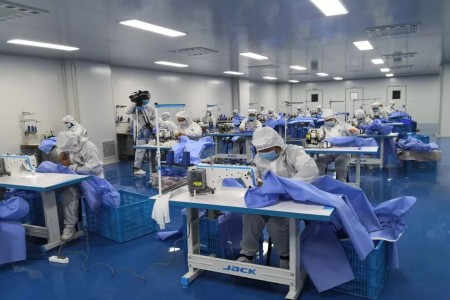2023/6/16

Disposable Isolation Gown vs. Microporous Coverall: A Comparison
Both disposable isolation gowns and microporous coveralls serve as protective barriers in healthcare settings, but they differ significantly in their design, protection levels, and intended applications. Understanding these differences is crucial for selecting the appropriate garment for specific situations.
Disposable Isolation Gown
Design: Lightweight and typically made of non-woven fabric, usually polypropylene or polyethylene. They feature a front closure, elastic cuffs, and a neck opening.
Protection Level: Primarily designed to prevent the wearer's clothing from becoming contaminated with bodily fluids and to protect the wearer from splashes and sprays. They offer limited protection against airborne particles.
Applications: Primarily used in healthcare settings for procedures involving potential exposure to bodily fluids, such as blood, vomit, or urine. They are also used for general patient care and infection control.
Advantages: Lightweight, comfortable, and inexpensive.
Disadvantages: Limited protection against airborne particles, less durable than coveralls.
Microporous Coverall
Design: Made from a non-woven fabric with a microporous membrane that allows air to pass through while preventing the passage of liquids and particles. They feature a zippered front closure, elastic cuffs, and a hood.
Protection Level: Offers a higher level of protection than isolation gowns, providing a barrier against both liquid splashes and airborne particles.
Applications: Used in environments where exposure to hazardous materials, including airborne contaminants, is a concern. Common applications include handling hazardous chemicals, working in cleanrooms, and performing procedures involving high-risk pathogens.
Advantages: Offers greater protection against airborne particles and liquids, more durable than isolation gowns.
Disadvantages: Less breathable than isolation gowns, heavier and less comfortable to wear.
Choosing the Right Garment
The choice between a disposable isolation gown and a microporous coverall depends on the specific situation and the level of protection required.
Use a disposable isolation gown when:
Protection from splashes and sprays of bodily fluids is needed.
General patient care and infection control are required.
A lightweight and comfortable garment is preferred.
Use a microporous coverall when:
Protection from airborne particles and liquids is needed.
Working with hazardous materials or in environments with high-risk pathogens is required.
A higher level of protection is necessary.
In summary
Disposable isolation gowns offer basic protection from splashes and sprays, while microporous coveralls provide a higher level of protection against both liquids and airborne particles. The choice between the two depends on the specific application and the level of protection required.




 WhatsApp
WhatsApp
Send us your message
You can send an email asking for the price and detailed information of this product. We will reply you as soon as we receive your email